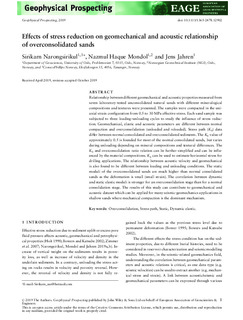Effects of stress reduction on geomechanical and acoustic relationship of overconsolidated sands
Peer reviewed, Journal article
Published version
Permanent lenke
http://hdl.handle.net/11250/2630161Utgivelsesdato
2019Metadata
Vis full innførselSamlinger
- NGI articles [1037]
Sammendrag
Relationship between different geomechanical and acoustic properties measured from seven laboratory tested unconsolidated natural sands with different mineralogical compositions and textures were presented. The samples were compacted in the uniaxial strain configuration from 0.5 up to 30 MPa effective stress. Each sand sample was subjected to three loading – unloading cycles to study the influence of stress reduction. Geomechanical, elastic, and acoustic parameters are different between normal compaction and overconsolidation (unloaded and reloaded). Stress path (K0) data differs between normal consolidated and overconsolidated sediments. The K0 value of approximately 0.5 is founded for most of the normal consolidated sands, but varies during unloading depending on mineral compositions and textural differences. The K0 and Overconsolidation Ratio (OCR) relation can be further simplified and can be influenced by the material compositions. K0 can be used to estimate horizontal stress for drilling applications. The relationship between acoustic velocity and geomechanical is also found to be different between loading and unloading conditions. The static moduli of the overconsolidated sands are much higher than normal consolidated sands as the deformation is small (small strain). The correlation between dynamic and static elastic moduli is stronger for an overconsolidation stage than for a normal consolidation stage. The results of this study can contribute to geomechanical and acoustic dataset which can be applied for many seismic‐geomechanics applications in shallow sands where mechanical compaction is the dominant mechanism. Effects of stress reduction on geomechanical and acoustic relationship of overconsolidated sands
